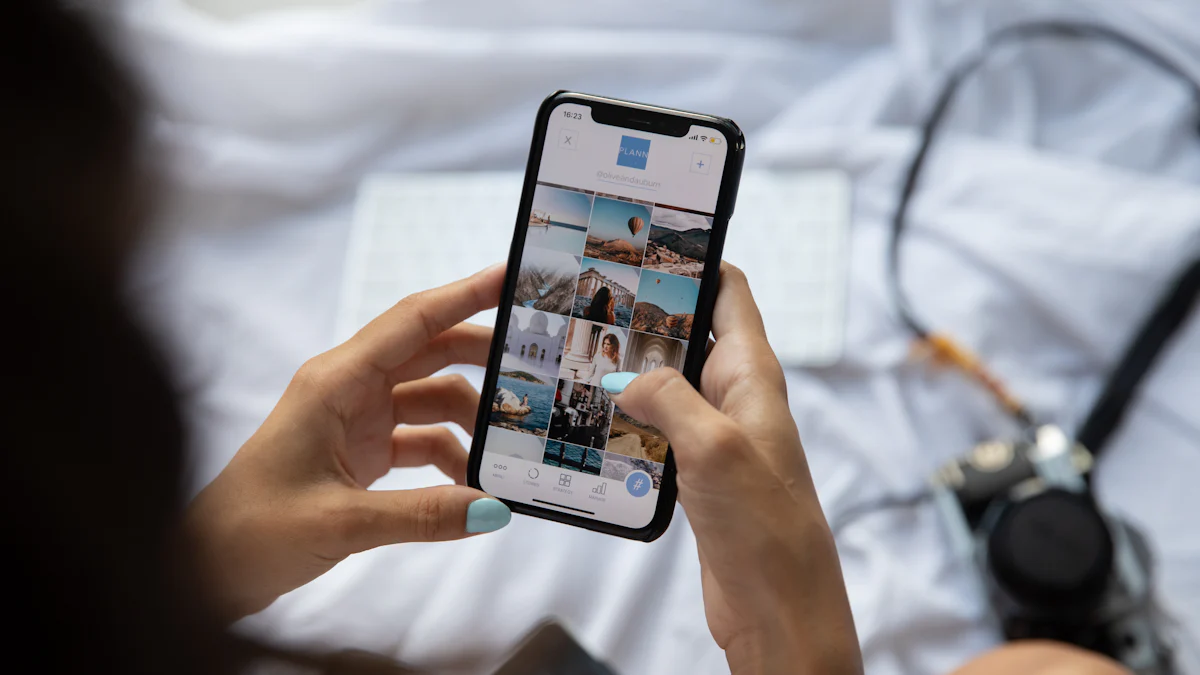Effective Ways to Enhance Influencer Marketing for Your Business

In 2025, influencer marketing has become a $21.1 billion industry, transforming how businesses connect with consumers. You can no longer rely on traditional ads to build trust or drive sales. Influencer marketing delivers 11 times the ROI of banner ads, making it a game-changer for growth. However, challenges like authenticity and rising costs demand smarter strategies. By aligning with influencers who share your values and focusing on engagement, you can overcome these hurdles. Partnering with an influencer marketing consultant ensures you achieve measurable results and stay ahead in this competitive landscape.
Key Benefits of Influencer Marketing

Building Brand Awareness
You want your brand to stand out in a crowded market. Influencer marketing helps you achieve this by amplifying your reach. When influencers share your products with their followers, your brand gains visibility among audiences you might not reach otherwise. This strategy allows you to connect with potential customers who trust the influencer's recommendations.
To measure success, define clear KPIs at the start of your campaign. Track metrics like follower growth and engagement quality to understand how well your efforts are working. Monitoring these KPIs ensures you can evaluate the financial impact and cost-effectiveness of your campaigns. By focusing on measurable results, you can maximize the visibility of your brand and assess its overall impact.
Driving Engagement and Trust
Trust is the foundation of any successful marketing strategy. Influencer marketing excels at building trust because influencers often have close relationships with their followers. Micro- and nano-influencers, in particular, maintain higher engagement rates due to their smaller, more loyal audiences. Their recommendations feel genuine, which encourages followers to engage with your brand.
A report by Sprout Social reveals that 64% of consumers trust social media influencer recommendations. This trust translates into increased leads and sales. When influencers share personal experiences with your products, their endorsements resonate more deeply. You can leverage this trust to create meaningful connections with your target audience.
Increasing Conversions and Sales
Ultimately, your goal is to drive sales, and influencer marketing delivers results. By collaborating with influencers who align with your brand, you can create authentic content that motivates consumers to take action. Influencers act as a bridge between your brand and their audience, making it easier for potential customers to trust your offerings.
Shoppable content, for example, simplifies the buying process. When influencers share direct links to your products, they remove barriers to purchase. This seamless experience encourages higher conversion rates. By focusing on authentic partnerships and actionable content, you can turn engagement into tangible sales growth.
Effective Influencer Marketing Strategies
Collaborating with Micro-Influencers
Benefits of micro-influencers for targeted reach
Micro-influencers are a powerful asset for your influencer marketing campaigns. They offer several advantages over macro-influencers:
- They maintain higher engagement rates because of their close connection with followers.
- Their content feels more authentic since it’s driven by passion, not just financial incentives.
- They’re budget-friendly, making them ideal for smaller brands or businesses with limited marketing budgets.
- They often act as long-term brand ambassadors, fostering ongoing relationships rather than one-off promotions.
- Their niche audiences allow you to target specific demographics effectively, ensuring your message reaches the right people.
By collaborating with micro-influencers, you can achieve genuine engagement and validate your target audience for specific products. For example, Sperry partnered with 100 micro-influencers during the rainy season, resulting in a 66% increase in website traffic and 4.7 million impressions. This demonstrates how micro-influencers can amplify your brand’s reach while staying cost-effective.
Steps to identify and partner with micro-influencers
Finding the right micro-influencers requires a strategic approach. Start by identifying influencers whose values align with your brand. Use tools like BuzzSumo or Upfluence to analyze their audience demographics and engagement rates. Next, evaluate their content quality and ensure it resonates with your target audience.
Once you’ve shortlisted potential partners, reach out with a personalized pitch. Highlight how your collaboration benefits both parties. Offer incentives like free products, commissions, or exclusive access to your brand. Building a strong relationship from the start ensures a successful partnership.
Creating Shoppable Content
How shoppable content drives direct sales
Shoppable content transforms inspiration into action. It allows consumers to purchase products directly from posts, videos, or live streams. This seamless shopping experience eliminates barriers, making it easier for customers to buy. By integrating clickable links or tags, you can guide users straight to your product pages, boosting conversions.
Live shopping events are particularly effective. They create urgency and excitement, encouraging real-time purchases. For instance, AR and VR technologies enhance this experience by letting customers visualize products in their environment. These tools make your content more interactive and engaging, driving higher sales.
Examples of successful shoppable campaigns
Brands like Dyson and Dunkin’ have mastered shoppable content. Dyson’s collaboration with micro-influencers in the beauty sector generated over 1 million views and a 10% engagement rate. Dunkin’s “Sipping is Believing” campaign targeted millennial influencers, resulting in coffee-centric content that attracted new customers. These examples highlight how shoppable content can deliver measurable results for your business.
Hosting Live Events and Video Collaborations
Engaging audiences through live streaming
Live streaming is a game-changer for audience engagement. It allows you to connect with viewers in real time, fostering a sense of community. Platforms like Instagram Live and YouTube enable you to showcase your products, answer questions, and interact directly with your audience.
Consumers prefer video content for product information, with 80% favoring it over text. Hosting live events with influencers amplifies this impact. Virtual attendance extends your reach globally, while interactive features like polls and Q&A sessions keep viewers engaged. Post-event recordings also provide lasting value, allowing attendees to revisit key moments.
Tips for impactful influencer-hosted events
To make your live events successful, choose influencers who align with your brand and have an engaged following. Plan the event carefully, ensuring it offers value to your audience. For example, Armani Beauty’s live makeup tutorial with influencers Camila Coelho and @songofstyle attracted a large crowd and boosted engagement.
Incorporate storytelling to make the event memorable. Use visuals, demonstrations, and behind-the-scenes content to captivate viewers. Finally, promote the event across all channels to maximize attendance and impact. By hosting well-executed live events, you can strengthen your connection with your audience and drive meaningful results.
Building Long-Term Partnerships
Advantages of ongoing collaborations
Long-term partnerships with influencers offer unmatched benefits for your brand. These collaborations create a steady stream of content, increasing brand recognition and driving higher sales over time. Consistency from a few trusted influencers builds stability, making your brand more memorable to their audience.
Ongoing relationships also foster creativity. Influencers feel more comfortable experimenting with ideas, leading to innovative campaigns that deliver a higher ROI. You gain valuable feedback from influencers, helping you refine your marketing strategies. Trust grows over time, encouraging honest communication and authentic content creation.
Long-term partnerships also improve campaign planning. Familiarity with an influencer’s performance allows you to predict outcomes and take calculated risks. Satisfied influencers may even recommend your brand to others, expanding your network. These advantages make long-term collaborations a cornerstone of effective influencer marketing strategies.
Strengthening brand-influencer relationships
Building strong relationships with influencers requires effort and mutual respect. Start by treating influencers as partners, not just marketing tools. Share your brand’s vision and involve them in the creative process. This approach fosters a sense of ownership, motivating them to deliver their best work.
Regular communication is key. Schedule check-ins to discuss campaign progress and gather feedback. Show appreciation for their contributions through incentives like exclusive perks or bonuses. These gestures strengthen loyalty and encourage long-term commitment.
By investing in these relationships, you create a team of passionate advocates who genuinely believe in your brand. This authenticity resonates with their audience, amplifying your message and driving better results.
Leveraging Emerging Platforms and Trends
Exploring new social media platforms
To stay ahead, you must explore emerging platforms where your audience spends time. TikTok, Instagram, and YouTube dominate among Gen Z and Millennials, while Facebook and Pinterest remain popular across all demographics.
| Consumer Demographic | Top Platforms for Social Commerce |
|---|---|
| All Consumers | Facebook, YouTube, TikTok, Instagram, Pinterest |
| Millennial Consumers | Facebook, TikTok, YouTube, Instagram, Pinterest |
| Gen Z Consumers | TikTok, Instagram, YouTube, Facebook, Pinterest |
A trusted influencer can guide their followers to new platforms. In fact, 61% of consumers are likely to try a platform if an influencer they trust posts there. However, avoid chasing every trend. As Samantha Hofherr of ILIA Beauty advises, align trends with your brand’s identity to maintain authenticity.
Incorporating AI and AR into campaigns
AI and AR technologies are revolutionizing influencer marketing. AI helps you analyze consumer data, enabling personalized campaigns that resonate with your audience. AR creates immersive experiences, like Sephora’s virtual try-ons, which boost customer confidence.
These tools also enhance storytelling. National Geographic uses AR to craft dynamic content that captivates viewers. Real-time AI optimizations during live campaigns improve engagement, while AR showcases products in innovative ways. Nike’s AR campaigns, for example, allow users to explore products interactively, leaving a lasting impression.
By integrating AI and AR, you can elevate your campaigns, create memorable experiences, and achieve measurable results. These technologies are essential for staying competitive in the evolving influencer marketing landscape.
Tips for Selecting the Right Influencers

Aligning with Brand Values
Evaluating shared values and messaging
Choosing influencers who align with your brand values ensures authenticity and consistency in your messaging. Start by identifying your core values and researching influencers who share similar principles. Look at their content to assess its tone, style, and relevance to your brand. For example, Gymshark’s collaboration with @SopheAllen highlights how shared values can create authentic content that resonates with audiences.
Communicate your expectations clearly during initial discussions. While doing so, respect the influencer’s creative freedom. This balance fosters a partnership where both parties feel valued. By aligning with influencers who genuinely reflect your brand, you can build trust with your target audience and create impactful campaigns.
Ensuring authenticity in influencer partnerships
Authenticity drives engagement. Influencers like @ChrissaSparkles, who partnered with Joybird, showcase how genuine connections with a brand can enhance credibility. Look for influencers who have a history of creating authentic content and engaging directly with their followers. Fiji Water’s campaign with Danielle Bernstein is another example of how authentic partnerships can generate user-generated content and boost visibility.
Analyzing Performance Metrics
Key metrics for influencer evaluation
Evaluating influencers requires a focus on key performance metrics. Analyze audience demographics such as age, gender, and location to ensure alignment with your target audience. Dive deeper into psychographics, including interests, values, and buying behavior, to tailor campaigns effectively.
Engagement rates are equally important. High follower counts mean little if the influencer’s audience isn’t actively engaging with their content. Prioritize influencers who consistently generate likes, comments, and shares, as these indicate a loyal and interested audience.
Tools for performance analysis
Leverage tools like Upfluence or BuzzSumo to simplify performance analysis. These platforms consolidate metrics like reach, impressions, clicks, and conversions into a single dashboard. Advanced features, such as enhanced link tracking, help measure campaign impact. Competitor analysis tools also provide insights to refine your influencer marketing strategies. Using these tools ensures you maximize ROI and make data-driven decisions.
Prioritizing Audience Fit
Matching influencers with target demographics
Your influencer’s audience should mirror your target audience. Use AI tools to analyze profiles and gather data on demographics and engagement rates. Research their past collaborations to ensure their content aligns with your brand. For instance, micro- and nano-influencers often have niche audiences that can deliver higher engagement and relevance for your campaigns.
Ensuring audience engagement and relevance
Focus on influencers with proven engagement quality. Look beyond follower counts and evaluate how their audience interacts with their content. Set clear campaign goals and define your target audience to improve ROI. Influencers who have a track record of driving conversions, like those used in effective influencer marketing strategies, can help you achieve measurable results.
Measuring ROI and Optimizing Campaigns
Setting Clear Goals and KPIs
Defining success metrics for campaigns
To measure the success of your influencer marketing campaigns, you need clear goals and KPIs. Start by defining a single overarching goal, such as increasing brand awareness or driving sales. Break this down into smaller, actionable micro-goals. Ensure your goals follow the SMART framework—Specific, Measurable, Achievable, Relevant, and Time-Bound.
For example, if your campaign focuses on engagement, set KPIs like likes, comments, and shares. Research industry benchmarks to make your goals competitive yet realistic. Adjust these KPIs based on your budget and timeline to ensure they remain achievable. By aligning your goals with measurable metrics, you can track progress and optimize your efforts effectively.
Examples of measurable KPIs
Here are some KPIs you can use to evaluate your campaigns:
| KPI | Description |
|---|---|
| Reach and impressions | Measures how many people saw your content. |
| Earned media value (EMV) | Assigns advertising value to earned coverage, calculated as Total impressions X Cost Per Mille (CPM). |
| Engagement | Tracks interactions like likes, comments, and shares, showing how well your audience connects with the content. |
| Conversions | Monitors direct sales or actions taken due to your campaigns. |
You can also track sales revenue or average order value (AOV) to assess the financial impact of your campaigns. These metrics provide a clear picture of your campaign’s performance.
Tracking Campaign Performance
Tools for monitoring ROI
Tracking ROI is essential for refining your digital marketing strategies. Tools like Traackr and Aspire offer advanced analytics, campaign management, and audience insights. Meltwater helps you monitor influencer performance and competitor activity. Google Analytics is another excellent option for tracking website traffic and conversions.
Sprout Influencer Marketing enhances tracking with UTMs and custom URLs, making it easier to measure campaign impact. By using these tools, you can consolidate data and gain a comprehensive view of your campaign’s success.
Using data to refine strategies
Analyzing campaign data helps you understand what works and what doesn’t. For instance, tracking engagement rates reveals which content resonates most with your audience. Use these insights to adjust your messaging and improve future campaigns.
Data also provides valuable information about customer behavior and preferences. This allows you to create targeted campaigns that align with your audience’s needs. Regular analysis fosters continuous improvement, ensuring your influencer marketing efforts remain competitive.
Scaling Successful Strategies
Identifying and replicating effective tactics
To scale your campaigns, identify tactics that deliver the best results. Focus on influencers who consistently produce high-quality content and engage their audience effectively. Align your goals with these successful strategies to maximize their impact.
For example, if a specific influencer drives high conversions, replicate their approach across similar campaigns. This ensures you build on proven methods while minimizing risks.
Adapting campaigns based on insights
Flexibility is key to scaling your efforts. Use performance data to adapt your campaigns and stay ahead of trends. For instance, if engagement rates drop, experiment with new content formats or platforms.
By continuously refining your strategies, you can expand your reach and achieve long-term success. Scaling your influencer marketing campaigns ensures you maximize ROI and maintain a competitive edge.
Adopting effective influencer marketing strategies in 2025 is essential for staying competitive. By focusing on authentic partnerships and leveraging emerging trends, you can build trust, drive engagement, and boost sales.
To succeed, evaluate influencers beyond follower counts. Prioritize engagement rates and proven results. Use AI tools to analyze profiles and audience demographics. Set clear goals, like increasing conversions, and track KPIs such as reach and engagement. Platforms like Google Analytics and HypeAuditor simplify performance tracking and ensure data-driven decisions.
Start planning today. Build long-term relationships with influencers who align with your brand. These partnerships foster loyalty and amplify your message. Implement these strategies to achieve measurable growth and elevate your business.
FAQ
How do I choose the right influencer for my brand?
Focus on influencers who share your brand’s values and have an engaged audience. Use tools like Upfluence to analyze their demographics and performance. Prioritize authenticity over follower count.
Tip: Look for influencers who create content that aligns with your brand’s tone and style.
What’s the difference between micro- and macro-influencers?
Micro-influencers have smaller, niche audiences with higher engagement rates. Macro-influencers have larger followings but may lack personal connections with their audience. Micro-influencers are ideal for targeted campaigns, while macro-influencers work well for broad reach.
Note: Micro-influencers often deliver better ROI for smaller budgets.
How can I measure the success of an influencer campaign?
Track KPIs like engagement, reach, and conversions. Use tools like Google Analytics or Traackr to monitor performance. Set clear goals before launching your campaign to evaluate its impact effectively.
Tip: Focus on metrics that align with your campaign objectives, such as sales or brand awareness.
Should I invest in long-term influencer partnerships?
Yes! Long-term collaborations build trust and consistency. Influencers become authentic advocates for your brand, creating stronger connections with their audience. This approach also fosters creativity and delivers better results over time.
Reminder: Strong relationships with influencers lead to more impactful campaigns.
Are emerging platforms worth exploring for influencer marketing?
Absolutely! Platforms like TikTok and AR-enhanced apps attract younger audiences and offer innovative ways to engage. Experiment with these platforms to stay ahead of trends and reach untapped demographics.
Pro Tip: Test new platforms with small campaigns before scaling your efforts.
See Also
7 Essential Steps for Crafting Your Influencer Strategy
Navigating Influencer Marketing Tools for Small Enterprises
7 Key Steps to Create Your Influencer Marketplace
